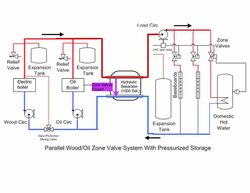After a long regression to lurking, finishing renovations and wondering if I ever would hook up my BioMass I'm back.
Here is my situation
2 500 gal tanks stacked horizontally, welded up to be a hydraulic separator
1 BioMass 40
3 Zones Radiant
2 Zone Radiators
Electric hot water which I'd either like to hook up with a side arm or by immersing a copper coil in my tanks using a "manport" with two threaded fitting in it I had put in the tanks.
I've attached a lightly modified version of Simplest Pressurized and I am wondering If there is anything different I can/should do with the Circs or anything else because of the hydraulic separator.
(maybe I don't need a Load Circ?)
Also: I will be using an electric boiler as backup and I'm wondering if it makes sense to run it through the tanks or if I should should I bypass them somehow. The scenario I'm trying to avoid would be coming back after a weekend away with the tanks warmed by expensive electricity.
Thanks In Advance for your help
Augie
Here is my situation
2 500 gal tanks stacked horizontally, welded up to be a hydraulic separator
1 BioMass 40
3 Zones Radiant
2 Zone Radiators
Electric hot water which I'd either like to hook up with a side arm or by immersing a copper coil in my tanks using a "manport" with two threaded fitting in it I had put in the tanks.
I've attached a lightly modified version of Simplest Pressurized and I am wondering If there is anything different I can/should do with the Circs or anything else because of the hydraulic separator.
(maybe I don't need a Load Circ?)
Also: I will be using an electric boiler as backup and I'm wondering if it makes sense to run it through the tanks or if I should should I bypass them somehow. The scenario I'm trying to avoid would be coming back after a weekend away with the tanks warmed by expensive electricity.
Thanks In Advance for your help
Augie


